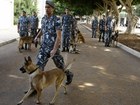Authorities in Russia's Siberian region of Tuva on Monday were examining several pieces of the Progress cargo spaceship found after it crashed last week having failed to reach orbit.
Two pieces, including a large spherical object, were found by herders over the weekend, while another was discovered in the courtyard of a residential house on Monday, said the region's head Sholban Karaa-ool, warning people not to touch any metal debris.
 Full Story
Full Story
Retired U.S. astronaut and the second man to walk on the moon, Buzz Aldrin, was recovering after his medical evacuation from Antarctica but is not yet able to return home, his manager Christina Korp said Sunday.
 Full Story
Full Story
Virgin Galactic's new spaceship has made a successful first glide flight, a key step after a deadly crash of its predecessor two years ago, the spaceflight company said on Saturday.
The new SpaceShipTwo, dubbed VSS Unity, was hoisted aloft by carrier airplane WhiteKnightTwo VMS Eve from the Mojave Air & Space Port in California, the company said on Twitter.
 Full Story
Full Story
An unmanned cargo ship traveling to the International Space Station burned up in the atmosphere shortly after launching Thursday, the Russian space agency said, raising concerns over space travel safety.
 Full Story
Full Story
Struck by the legendary sniffing skills of man's best friend, scientists in the United States fitted a dog-inspired plastic nose to an explosives detector, and reported Thursday it worked much better.
 Full Story
Full Story
Buzz Aldrin, the 86-year-old retired U.S. astronaut who was among the first men to walk on the Moon, has been evacuated from the South Pole for medical reasons, officials said Thursday.
Aldrin was visiting the South Pole as part of a tourist group, when his "condition deteriorated," said a statement from the operator, White Desert.
 Full Story
Full Story
The periodic table got larger Wednesday after four new elements were officially named and added to the chart, including 'nihonium' -- the first ever to be discovered by Japanese scientists.
The new name for element 113, a highly radioactive element with an extremely short half-life, comes from Japan's name in Japanese -- 'nihon', literally 'the land of the rising sun'.
 Full Story
Full Story
A mass bleaching event on the Great Barrier Reef this year killed more corals than ever before, scientists said Tuesday, sounding the alarm over the delicate ecosystem.
The 2,300-kilometre (1,400-mile) long reef -- the world's biggest -- suffered its most severe bleaching in recorded history, due to warming sea temperatures during March and April, with the northern third bearing the brunt.
 Full Story
Full Story
Astronauts may experience blurry vision and impaired eyesight after long spaceflights due to changes in spinal fluid that occur while in microgravity, researchers said Monday.
 Full Story
Full Story
NASA on Saturday blasted off a new satellite designed to offer a "huge leap" in weather forecasting by sending back more frequent and higher-definition images of severe weather patterns, the U.S. space agency said.
Known as GOES-R (Geostationary Operational Environmental Satellites), the satellite was built by Lockheed Martin and lifted off atop a United Launch Alliance Atlas V rocket at 6:42 pm (2342 GMT).
 Full Story
Full Story



